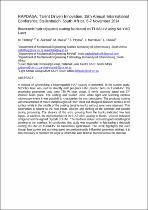JavaScript is disabled for your browser. Some features of this site may not work without it.
- ResearchSpace
- →
- Research Publications/Outputs
- →
- Conference Publications
- →
- View Item
| dc.contributor.author |
Tlotleng, Monnamme

|
|
| dc.contributor.author |
Akinlabi, E

|
|
| dc.contributor.author |
Shukla, M

|
|
| dc.contributor.author |
Pityana, Sisa L

|
|
| dc.contributor.author |
Mathebula, T

|
|
| dc.contributor.author |
Chauke, Levy

|
|
| dc.date.accessioned | 2015-05-25T10:52:00Z | |
| dc.date.available | 2015-05-25T10:52:00Z | |
| dc.date.issued | 2014-11 | |
| dc.identifier.citation | Tlotleng, M., Akinlabi, E., Shukla, M., Pityana, M., Mathebula, T. and Chauke, L. 2014. Bioceramic hydroxyapatite coating fabricated on TI-6Al-4V using Nd: YAG Laser. In: RAPDASA, Talent Driven Innovation, 15th Annual International Conference, Stellenbosch, South Africa, 6-7 November 2014 | en_US |
| dc.identifier.uri | http://conferences.sun.ac.za/public/conferences/24/schedConfs/31/program-en_US.pdf | |
| dc.identifier.uri | http://hdl.handle.net/10204/7975 | |
| dc.description | 15th Annual International Conference, Stellenbosch, South Africa, 6-7 November 2014. Due to copyright restrictions, the attached PDF file contains the abstract of the full text item. For access to the full text item, please consult the publisher's website | en_US |
| dc.description.abstract | A method of synthesising a biocompatible HAP coating is presented. In the current study, Nd:YAG laser was used to directly melt pre-place HAP powder beds on Ti-6Al-4V. The processing parameters used were 750 W laser power, 5 mm/s scanning speed and 27° inclined beam plane. The coating was studied under white light and scanning electron microscope where it was possible to characterise the microstructures. The produced coating was characterised of mixed morphologies of HAP, short and elongated titanium needles at the surface while in the middle of the coating dendrite trunks without arms were observed. This observation is related to the heat inputs, dilution and melting of the substrate and powder during processing. The absence of the arms growing from the trunks indicated low heat inputs. In addition, the microstructure of the HAP after soaking in Hanks’ solution indicated octagonal and hexagonal crystals of HAP. The hardness values indicated good metallurgical bonding at the interface. In conclusion, this study was successful in fabricating a desirable coating of HAP on Ti-6Al-4V for biomedical applications. This work highlights that even though laser power and scanning speed are predominantly influential parameter settings, it is also necessary to consider the angle at which the laser beam is scanned across the material. | en_US |
| dc.language.iso | en | en_US |
| dc.publisher | BA Crawford Specialised Publications | en_US |
| dc.relation.ispartofseries | Workflow;14312 | |
| dc.subject | Coatings | en_US |
| dc.subject | Hydroxyapatite | en_US |
| dc.subject | Dendrites | en_US |
| dc.subject | Laser | en_US |
| dc.subject | Nd-YAG | en_US |
| dc.subject | Titanium alloy | en_US |
| dc.subject | Titanium Needles | en_US |
| dc.title | Bioceramic hydroxyapatite coating fabricated on TI-6Al-4V using Nd:YAG Laser | en_US |
| dc.type | Conference Presentation | en_US |
| dc.identifier.apacitation | Tlotleng, M., Akinlabi, E., Shukla, M., Pityana, S. L., Mathebula, T., & Chauke, L. (2014). Bioceramic hydroxyapatite coating fabricated on TI-6Al-4V using Nd:YAG Laser. BA Crawford Specialised Publications. http://hdl.handle.net/10204/7975 | en_ZA |
| dc.identifier.chicagocitation | Tlotleng, Monnamme, E Akinlabi, M Shukla, Sisa L Pityana, T Mathebula, and Levy Chauke. "Bioceramic hydroxyapatite coating fabricated on TI-6Al-4V using Nd:YAG Laser." (2014): http://hdl.handle.net/10204/7975 | en_ZA |
| dc.identifier.vancouvercitation | Tlotleng M, Akinlabi E, Shukla M, Pityana SL, Mathebula T, Chauke L, Bioceramic hydroxyapatite coating fabricated on TI-6Al-4V using Nd:YAG Laser; BA Crawford Specialised Publications; 2014. http://hdl.handle.net/10204/7975 . | en_ZA |
| dc.identifier.ris | TY - Conference Presentation AU - Tlotleng, Monnamme AU - Akinlabi, E AU - Shukla, M AU - Pityana, Sisa L AU - Mathebula, T AU - Chauke, Levy AB - A method of synthesising a biocompatible HAP coating is presented. In the current study, Nd:YAG laser was used to directly melt pre-place HAP powder beds on Ti-6Al-4V. The processing parameters used were 750 W laser power, 5 mm/s scanning speed and 27° inclined beam plane. The coating was studied under white light and scanning electron microscope where it was possible to characterise the microstructures. The produced coating was characterised of mixed morphologies of HAP, short and elongated titanium needles at the surface while in the middle of the coating dendrite trunks without arms were observed. This observation is related to the heat inputs, dilution and melting of the substrate and powder during processing. The absence of the arms growing from the trunks indicated low heat inputs. In addition, the microstructure of the HAP after soaking in Hanks’ solution indicated octagonal and hexagonal crystals of HAP. The hardness values indicated good metallurgical bonding at the interface. In conclusion, this study was successful in fabricating a desirable coating of HAP on Ti-6Al-4V for biomedical applications. This work highlights that even though laser power and scanning speed are predominantly influential parameter settings, it is also necessary to consider the angle at which the laser beam is scanned across the material. DA - 2014-11 DB - ResearchSpace DP - CSIR KW - Coatings KW - Hydroxyapatite KW - Dendrites KW - Laser KW - Nd-YAG KW - Titanium alloy KW - Titanium Needles LK - https://researchspace.csir.co.za PY - 2014 T1 - Bioceramic hydroxyapatite coating fabricated on TI-6Al-4V using Nd:YAG Laser TI - Bioceramic hydroxyapatite coating fabricated on TI-6Al-4V using Nd:YAG Laser UR - http://hdl.handle.net/10204/7975 ER - | en_ZA |






